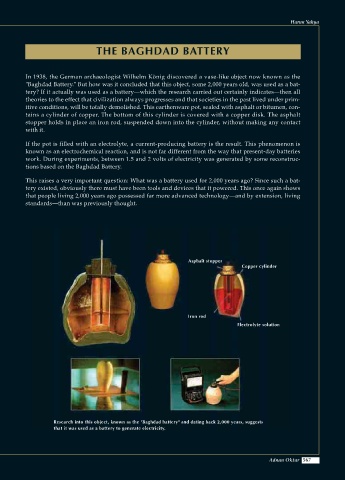Page 569 - Atlas of Creation Volume 2
P. 569
Harun Yahya
THE BAGHDAD BATTERY
In 1938, the German archaeologist Wilhelm König discovered a vase-like object now known as the
"Baghdad Battery." But how was it concluded that this object, some 2,000 years old, was used as a bat-
tery? If it actually was used as a battery—which the research carried out certainly indicates—then all
theories to the effect that civilization always progresses and that societies in the past lived under prim-
itive conditions, will be totally demolished. This earthenware pot, sealed with asphalt or bitumen, con-
tains a cylinder of copper. The bottom of this cylinder is covered with a copper disk. The asphalt
stopper holds in place an iron rod, suspended down into the cylinder, without making any contact
with it.
If the pot is filled with an electrolyte, a current-producing battery is the result. This phenomenon is
known as an electrochemical reaction, and is not far different from the way that present-day batteries
work. During experiments, between 1.5 and 2 volts of electricity was generated by some reconstruc-
tions based on the Baghdad Battery.
This raises a very important question: What was a battery used for 2,000 years ago? Since such a bat-
tery existed, obviously there must have been tools and devices that it powered. This once again shows
that people living 2,000 years ago possessed far more advanced technology—and by extension, living
standards—than was previously thought.
Asphalt stopper
Copper cylinder
Iron rod
Electrolyte solution
Research into this object, known as the "Baghdad battery" and dating back 2,000 years, suggests
that it was used as a battery to generate electricity.
Adnan Oktar 567

